Deadly body temperature for the human body is critical disturbance of heat exchange, which is accompanied by loss of consciousness, fever, decreased functional activity of internal organs, collapse of life support systems.
Record content:
- 1 Types of body temperature
- 2 Normal indicators of body temperature in a person by age
- 3 Body temperature that is fatal to humans
- 4 Causes and signs of hypothermia
- 5 The mechanism of hypothermia development
-
6 Causes and symptoms of hyperthermia
- 6.1 Heatstroke
- 6.2 Sunstroke
- 6.3 Diseases
- 7 Development of hyperthermia
-
8 First aid
- 8.1 At low temperatures
- 8.2 High temperature
- 9 What can not be done at high and low body temperature in humans
- 10 Video about human body temperature
Types of body temperature
Human body temperature changes under the influence of external and internal factors. The onset of death occurs in situations where the body loses its physiological ability to cool or heat tissues.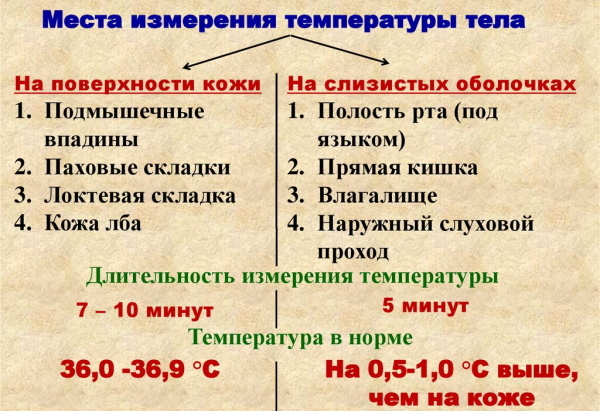
There are the following types of human body temperature:
- low - less than 35 degrees Celsius;
- normal - the temperature is in the range from 35 to 37 degrees;
- subfebrile - body temperature remains in the range of values from 37 to 38 degrees;
- febrile - high temperature with fever from 38 to 39 degrees;
- pyretic - expressed in the serious condition of the patient, as well as temperature indicators from 39 to 41 degrees;
- hyperpyretic - there is a real threat to a person's life, since in this case his body temperature exceeds 41 degrees.
Each type of temperature has a direct impact on the functions of internal organs, metabolic processes and the general well-being of a person. Violation of the body's heat exchange in the direction of increase requires the adoption of drugs with antipyretic properties.
For patients with critically low body temperature, urgent resuscitation measures are taken to stabilize the functions of internal organs, as well as to warm the body.
Normal indicators of body temperature in a person by age
The table below shows the normal body temperature in people of different age groups:
| Human age | Normal body temperature (indicator ° C) |
| Newborn child | 36,8 |
| Infant 6 months | 37,4 |
| 1 year old child | 37,4 |
| Children 3 years old | 37,4 |
| Child 6 years old | 37,0 |
| Men, women under 65 | 36,8 |
| People over 65 | 36,3 |
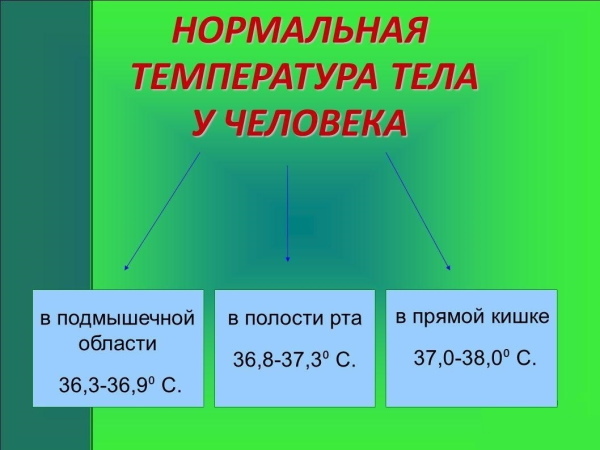 These temperature indicators are the norm for the armpit area. During the examination of a person, not only his age is taken into account, but also the possible presence of concomitant diseases, the individual characteristics of the organism, and the type of professional activity.
These temperature indicators are the norm for the armpit area. During the examination of a person, not only his age is taken into account, but also the possible presence of concomitant diseases, the individual characteristics of the organism, and the type of professional activity.
Body temperature that is fatal to humans
The lethal temperature for a person can be too high or very low. In both cases, a violation of metabolic processes occurs, the working capacity of internal organs decreases or is completely lost.
In conditions of severe hypothermia of the body, the onset of biological death occurs if the temperature drops below 28 °. In this situation, there is a numbness of all tissues involved in the implementation of the functions of the musculoskeletal system. Then there is a complete cardiac arrest and respiration.
Overheating is no less dangerous for the body, as it can lead to death. In conditions of hyperthermia, a pathological spasm of blood vessels occurs, which is fraught with impaired general circulation and cardiac arrest. The onset of death can occur if a person's body temperature is above 41 °.
The degree of lethality is influenced not only by the factor of disturbance of the body's heat exchange, but also by the main reasons that provoked the fever and fever of a person. Age, the level of functional activity of the heart, kidneys, blood vessels are of great importance.
Causes and signs of hypothermia
The deadly temperature for a person causes a failure of all life support systems of the body. The process can be gradual or instantaneous. It all depends on what external factors affect the body. The main reason for the development of hypothermia is severe hypothermia of the body.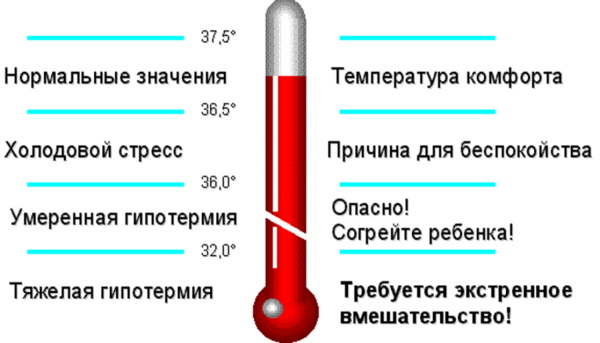
Violation of heat exchange in the direction of lowering temperature indicators can be caused by factors:
- falling into cold water;
- prolonged exposure to frost;
- exposure to chemicals, the properties of which are associated with the implementation of the freezing effect (for example, liquid nitrogen);
- prolonged hypothermia of the body in damp and cold weather, when the body is not properly protected by warm clothing.
In cold conditions, the human body begins to give off a large amount of energy. Heat loss occurs through the skin and respiratory system. Exposure to gusty wind accelerates the development of hypothermia.
The first signs of a decrease in body temperature are the appearance of a feeling of trembling and spasm of the blood vessels. In this situation, the body signals that it is necessary to urgently take measures aimed at warming the body. Otherwise, there will be a further increase in the symptoms of hyperthermia.
The symptom of hypothermia in the form of tremors is the body's defense mechanism. During tremors, an involuntary contraction of muscle tissues occurs, which begin to generate additional heat energy. Vascular spasm makes it possible to slow down the flow of blood, which goes towards the skin, lower and upper limbs.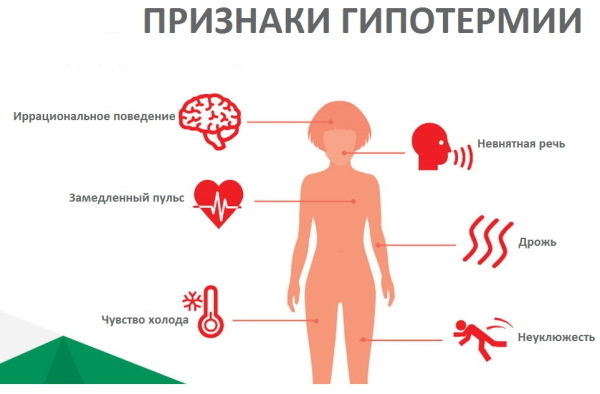
This symptom of hypothermia is also another heat-conserving mechanism. As the body temperature further decreases, the effect of slowing down the work of the respiratory system and the heart muscle develops. The main expenditure of thermal energy is directed to maintaining the full functions of the brain.
The following basic symptoms are distinguished, which indicate the onset of hypothermia:
- trembling of the whole body;
- confusion of thoughts and unclear consciousness;
- slurred speech;
- problems with coordination of movements (first of all, the work of the upper limbs is disrupted);
- extreme tiredness and a feeling of exhaustion;
- drowsiness;
- memory losses.
An outward sign of hypothermia may be overly red or pale skin. The human body becomes very cold. A drop in temperature to critical levels can cause symptoms of tissue stiffness.
The mechanism of hypothermia development
The table below shows the main mechanism and stages of the development of hyperthermia, which are characterized by the manifestation of certain signs of hypothermia:
| Severity of hypothermia | Body temperature indicator | The mechanism of development of critical hypothermia of the body and the corresponding symptoms of its manifestation |
| Easy | The human body temperature ranges from 32 to 35 °. | At this stage of the onset of hypothermia, severe hand tremors appear, which gradually passes to all other parts of the musculoskeletal system. There are signs of goose bumps. Then the epithelial tissues acquire a bluish tint, which indicates a pronounced spasm of blood vessels, a slowdown in general circulation. After that, memory problems arise, symptoms of confusion appear. The person's speech becomes illegible. |
| Moderate | Human body temperature ranges from 28 ° to 32 °. | At this stage, the mechanism for the development of hypothermia is accompanied by the appearance of drowsiness and visual hallucinations. Such signs of a pathological condition indicate that the body has turned on the mode of saving thermal energy even for brain tissues. A person has the effect of shaking feet, which excludes full movement of the lower limbs. |
| Strong | Body temperature readings are below 28 °. | At this stage of hypothermia of the body, the mechanism of development of hyperthermia is expressed in a complete cessation of heartbeat and respiration. Biological death sets in. |
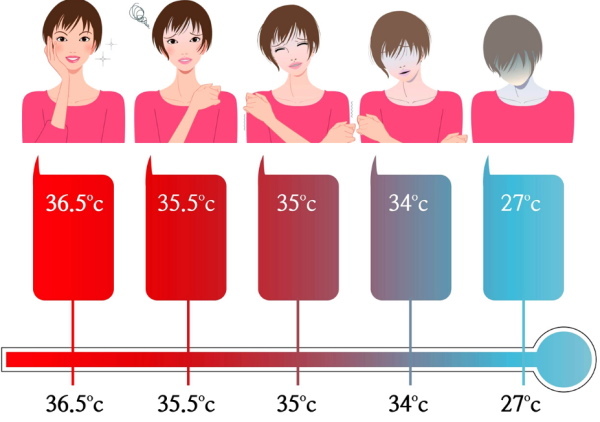
A case was recorded when a person with signs of hypothermia, whose body temperature was 16 °, was able to survive. At present, this indicator is a record for the preservation of the functions of internal organs in conditions of critical hypothermia of their tissues.
Causes and symptoms of hyperthermia
The deadly temperature for a person causes disturbances in the functioning of the heart and blood vessels. Hyperthermia occurs due to the maximum overstrain of the physiological mechanisms of the human body, which are involved in the process of thermoregulation.
If the factors that contribute to the increase in body temperature are not eliminated, this leads to the development of heatstroke. This condition is very dangerous for people who have acquired diseases of the cardiovascular system.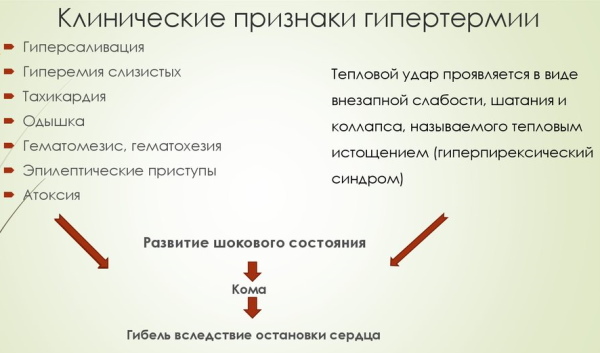
Symptoms of hyperthermia are distinguished, indicating that a person needs a decrease in body temperature indicators:
- increased sweating;
- violation of the body's heat exchange in the direction of a progressive increase in temperature;
- a change in the color tone of the skin, which can acquire a bright red, burgundy or bluish tint, depending on the state of the blood vessels and the human heart;
- violation of local and general circulation;
- oxygen starvation of the brain;
- dehydration of the body;
- loss of mineral salts;
- imbalance of electrolytes, the level of which decreases in proportion to the process of dehydration;
- heart palpitations;
- increased excitement of the nervous system;
- cramps of the lower extremities and the whole body;
- physical weakness;
- confusion of consciousness;
- feeling hot;
- visual and auditory hallucinations;
- loss of consciousness.
Timely measures taken to cool the body allow us to limit ourselves to mild symptoms. hyperthermia in the form of increased sweating, fever, heart palpitations and physical weakness.
Heatstroke
Heatstroke is a consequence of overheating the entire body.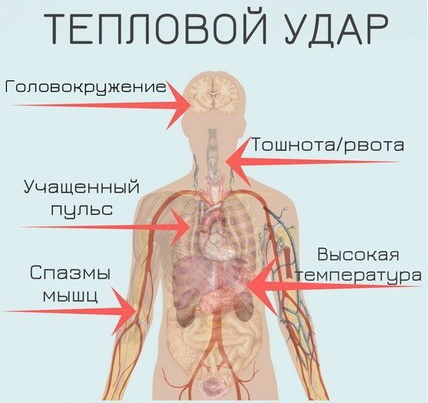
This type of pathological state of the body occurs in the following cases:
- a person is in hot weather or inside a stuffy room where dry and hot air prevails;
- for a long period of time, the body was exposed to the radiation of solar radiation;
- almost all areas of the skin are covered with warm dark-colored clothing when it is too hot outside or indoors.
Heatstroke has typical signs of hyperthermia. In this case, the appearance of additional symptoms in the form of nausea, vomiting, the appearance of dark circles and flies in front of the eyes is not excluded.
After the temperature of the human body reaches 42 °, the physiological processes of the breakdown of protein bonds begin, which leads to inevitable death. The largest number of deaths caused by heatstroke is annually recorded in Russia, Japan, Canada.
Sunstroke
The state of hyperthermia caused by sunstroke resembles thermal overheating of the body in its symptoms. In this situation, a violation of the functions of the brain occurs, which affects the performance of all internal organs and the musculoskeletal system.
At risk are people who have been in direct sunlight for a long time and do not wear hats in the hot season. The effects of sunstroke are exacerbated if the environment is too humid and there is no wind. This cause of hyperthermia can cause coma or death.
Diseases
Hyperthermia and a feverish state of the body, which is caused by an infectious or inflammatory disease, is much easier to tolerate than heat and sunstroke. In this situation, an increase in body temperature is not a violation in the work of thermoregulatory mechanisms, but a protective reaction of the body in response to the invasion of pathogenic microbes.
In hot conditions, the process of cell division of infectious agents significantly slows down or completely stops, and then their complete death occurs. Hyperthermia caused by the inflammatory process is much less likely to lead to death.
Development of hyperthermia
The development of hyperthermia occurs with the simultaneous effect of high ambient temperatures and factors that contribute to the dysfunction of thermoregulatory mechanisms. For example, critical overheating of the body occurs in people performing heavy physical work in direct sunlight.
At the same time, labor activity is carried out in the summer season, in hot and calm weather. The influence of an external source of thermal energy is aggravated by active contraction of muscle tissue, which also contributes to warming the body.
Violation of the thermal regulation of the body with the further development of hyperthermia can occur in men and women who are intoxicated.
First aid
The deadly temperature for a person causes a stop of the respiratory system and disrupts the functions of the central nervous system. To minimize the risk of death caused by hypothermia or critical overheating of the body, the victim should be provided with timely medical care.
The order of actions aimed at stabilizing the functions of internal organs depends on the general condition of the person, the causal factors that provoked a violation of the thermal regime of the body.
At low temperatures
People with signs of hypothermia need urgent hospitalization in the internal medicine department.
Before the arrival of an ambulance, it is necessary to perform actions aimed at warming the victim's body:
- A person with critical hypothermia should be moved to a room with warm air or any other shelter that protects from the effects of frost and cold wind.
- It is necessary to remove wet clothes from the surface of the victim's body, and then cover him with a blanket, or warm things that will speed up the process of returning to normal temperature.
The main focus of all actions aimed at warming a person with signs of hypothermia is on warming the neck, head, groin and chest. These are the parts of the body through which the greatest amount of heat energy is lost.
A person who is in a clear consciousness must be given warm drinks. In such a situation, it is recommended to brew black tea, make a decoction of chamomile or thyme. To increase the functional activity of the tissues of the heart and brain, the use of warm tea should be carried out with honey, or 3-4 tablespoons of sugar should be added to the drink.
After a person is completely warm, it is necessary to examine his body for possible damage, signs of frostbite.
The latter consequence of hypothermia is quite common, since as the hypothermia of the body slows down the local blood circulation in the tissues of the lower and upper limbs. Upon the arrival of ambulance doctors, the victim is hospitalized in a hospital.
If a person is unconscious, characterized by confusion of consciousness, the presence of delusional ideas, then you should not attempt to warm him up with hot drinks.
High temperature
First aid to a person who has signs of a critical increase in body temperature should be provided as quickly as possible.. Otherwise, there is a real risk of dysfunction of the heart, blood vessels and brain.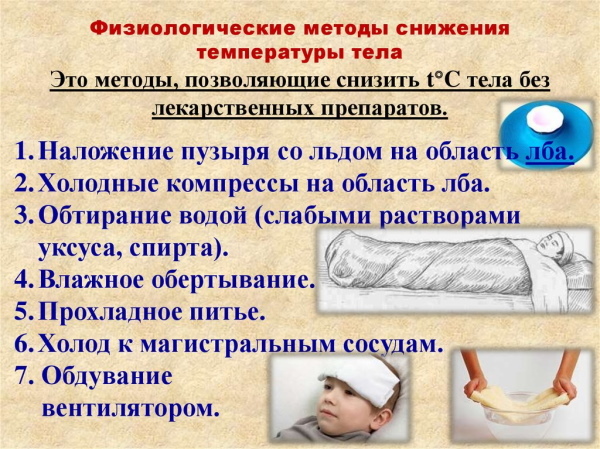
The person who provides first aid needs to follow the algorithm of actions:
- Call an ambulance, informing exactly what symptoms of hyperthermia are present in the patient.
- Move the person to a cool room. If there are no buildings nearby, then you need to find a shaded place where there is no direct sunlight.
- The patient should be laid down in a horizontal position, and a pillow or roller folded from personal belongings is placed under his head.
- Then soak a handkerchief or any other piece of clean cloth in cold water.
- Before the arrival of doctors, it is necessary to wipe the face, back of the head, neck and décolleté of the patient in order to accelerate the cooling process of the body, as well as prevent a further increase in temperature indicators.
- If possible, it is recommended to remove unnecessary things from the patient that contribute to warming the body.
- The organs of the respiratory system must be provided with an influx of fresh air, as this will avoid disruption of metabolic processes in the cells of the brain.
- It is necessary to collect 200-300 g of ice in a plastic bag, and then apply it to the occipital region of the patient's head.
The best therapeutic effect, aimed at cooling the human body with signs of hyperthermia, is achieved by pouring water over it with a temperature of 18 ° to 20 °. For this, the patient must be put in the bathroom, giving him a cool shower.
What can not be done at high and low body temperature in humans
During the provision of first aid to people with signs of hypothermia or overheating of the body, it is strictly forbidden to perform the following actions:
- rubbing hands, feet and other parts of the body of a person who has signs of critical hypothermia (these actions will lead to damage to the smallest blood vessels in the spasmodic condition);
- accelerate the warming process with alcoholic beverages;
- place a patient with signs of hypothermia in a hot bath (the process of warming the body should occur gradually);
- put on the back of a person who has hyperthermia, accompanied by nausea and periodic discharge vomit (a patient with these signs must be placed on one side so that the contents of his stomach do not get into trachea);
- place the patient under an air conditioner with a very cold stream of air;
- to help a person with hyperthermia, leaving him in direct sunlight.
 Human temperature is one of the physiological markers of the functional state of the body. The change in this indicator is influenced by the conditions of the microclimate of the environment, the age of the individual, the performance of internal organs, as well as the presence of concomitant diseases.
Human temperature is one of the physiological markers of the functional state of the body. The change in this indicator is influenced by the conditions of the microclimate of the environment, the age of the individual, the performance of internal organs, as well as the presence of concomitant diseases.
Normal body temperature is between 36 ° and 37 °. A decrease or increase in these indicators causes a gradual disruption of metabolic processes in the body, the work of the heart and respiratory organs slows down, the walls of blood vessels contract.
For a person to die, it is enough for his body temperature to fall below 28 °, or rise to the limit of 42 °. In the latter case, denaturation of protein compounds occurs.
Video about human body temperature
Temperature - norm and pathology:



